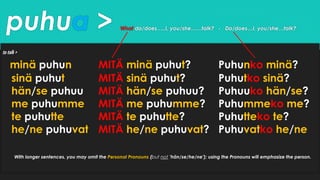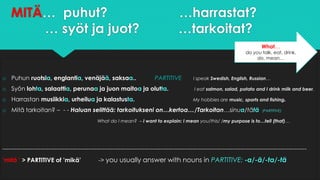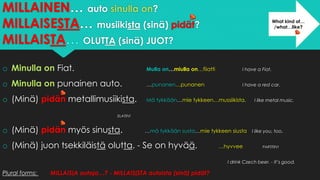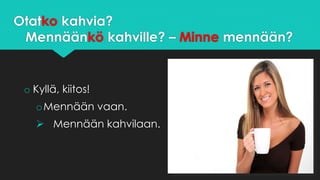Kysy
- 1. KYSY_ask questions KUKA (sin├ż) olet? who (Min├ż) olen Maria. MISS├ä (sin├ż) asut? where (Min├ż) asun Saksassa. KUINKA/miten vanha (sin├ż) olet? how (Min├ż) olen 26(-vuotias). MILLOIN (sin├ż) tulet Suomeen? when (Min├ż) tulen kes├żll├ż. MIKSI (sin├ż) opiskelet suomea? why Koska minulla on suomalaisia yst├żvi├ż. MITEN/kuinka (sin├ż) puhut suomea? how En kovin hyvin, mutta opin lis├ż├ż! MILLAINEN/mink├żlainen s├ż├ż on t├żn├ż├żn? whatŌĆ”like On aurinkoista, mutta tuulee. Question word + Subject +Verb +Object Subject = the person/thing, doing or acting (be, live, come, study, speak) Verb = what someone does Object = the direct result or object of doing (study -> suomea; speak -> suomea - PARTITIVE) Olla = to be Asua = to live Opiskella = to study Puhua = to speak, talk Ritva Tammi 2015
- 2. MIK├ä > mit├ż = what KUKA = who KUINKA/MITEN = how MIKSI = why MILLAINEN/mink├żlainen = whatŌĆ”like; what kind of MISS├ä = where MIST├ä = where from MIHIN/MINNE = where to
- 3. -ko/-k├Č QUESTION WORD o AsutKO (sin├ż) Saksassa? Do you live in Germany? asua > sin├ż asut o PuhutKO (sin├ż) suomea? Do you speak Finnish? puhua > sin├ż puhut o TuletKO (sin├ż) Suomeen? Do you come to Finland? tulla > sin├ż tulet o Pid├żtK├¢ (sin├ż) musiikista? Do you like music? pit├ż├ż > sin├ż pid├żt o OtatKO (sin├ż) kahvia? Will you have some coffee? ottaa > sin├ż otat -> ŌĆØKyll├żŌĆ”([min├ż] asun, puhun, tulen, pid├żn, otan)ŌĆØ -> ŌĆØEi...([min├ż] en asu, en puhu, en tule, en pid├ż, en ota)ŌĆØ -ko: with a, o, u; -k├Č: with i, e, ├ż, ├Č, y sin├ż asut asutko sin├ż?
- 4. puhua > What do/doesŌĆ”..I, you/sheŌĆ”ŌĆ”talk? - Do/doesŌĆ”I, you/sheŌĆ”talk? to talk > min├ż puhun MIT├ä min├ż puhut? Puhunko min├ż? sin├ż puhut MIT├ä sin├ż puhut? Puhutko sin├ż? h├żn/se puhuu MIT├ä h├żn/se puhuu? Puhuuko h├żn/se? me puhumme MIT├ä me puhumme? Puhummeko me? te puhutte MIT├ä te puhutte? Puhutteko te? he/ne puhuvat MIT├ä he/ne puhuvat? Puhuvatko he/ne With longer sentences, you may omit the Personal Pronouns (but not ŌĆÖh├żn/se/he/neŌĆÖ); using the Pronouns will emphasize the person.
- 5. MIT├äŌĆ” puhut? ŌĆ”harrastat? ŌĆ” sy├Čt ja juot? ŌĆ”tarkoitat? o Puhun ruotsia, englantia, ven├żj├ż├ż, saksaa.. PARTITIVE I speak Swedish, English, RussianŌĆ” o Sy├Čn lohta, salaattia, perunaa ja juon maitoa ja olutta. I eat salmon, salad, potato and I drink milk and beer. o Harrastan musiikkia, urheilua ja kalastusta. My hobbies are music, sports and fishing. o Mit├ż tarkoitan? ŌĆō - - Haluan selitt├ż├ż: tarkoitukseni onŌĆ”kertoaŌĆ”/TarkoitanŌĆ”sinua/t├żt├ż (PARTITIVE) What do I mean? ŌĆō I want to explain: I mean you/this/ /my purpose is toŌĆ”tell (that)ŌĆ” -------------------------------------------------------------------------------------------------------------------------------------------------------- ŌĆÖmit├ż ŌĆÖ > PARTITIVE of ŌĆÖmik├żŌĆÖ -> you usually answer with nouns in PARTITIVE: -a/-├ż/-ta/-t├ż WhatŌĆ” do you talk, eat, drink, do, meanŌĆ”
- 6. MILLAINENŌĆ” auto sinulla on? MILLAISESTAŌĆ” musiikista (sin├ż) pid├żt? MILLAISTAŌĆ” OLUTTA (sin├ż) JUOT? o Minulla on Fiat. Mulla onŌĆ”miulla onŌĆ”fiiatti I have a Fiat. o Minulla on punainen auto. ŌĆ”punanenŌĆ”punanen I have a red car. o (Min├ż) pid├żn metallimusiikista. M├ż tykk├ż├żnŌĆ”mie tykkeenŌĆ”mussiikista. I like metal music. ELATIIVI o (Min├ż) pid├żn my├Čs sinusta. ŌĆ”m├ż tykk├ż├żn sustaŌĆ”mie tykkeen siusta I like you, too. o (Min├ż) juon tsekkil├żist├ż olutta. - Se on hyv├ż├ż. ŌĆ”hyvvee PARTITIIVI I drink Czech beer. - ItŌĆÖs good. Plural forms: MILLAISIA autojaŌĆ”? - MILLAISISTA autoista (sin├ż) pid├żt? What kind ofŌĆ” /whatŌĆ”like?
- 7. MISS├äŌĆ” asut? MIST├äŌĆ” tulet? MINNE/MIHINŌĆ” menetŌĆ”olet menossa? ’éÜ (Min├ż) asun Joensuussa /Kiteell├ż. INESSIIVI I live in Joensuu /Kitee. ’éÜ (Min├ż) tulen Joensuusta /Kiteelt├ż. (also: Olen kotoisin/l├żht├ČisinŌĆ”) I come from Joensuu /Kitee. ’éÜ (Min├ż) tulen asemalta. ELATIIVI IŌĆÖm coming from the station. ’éÜ (Min├ż) menen ulos. IŌĆÖm going out. ’éÜ (Min├ż) menen kahville. - M├ż meen, mie m├ż├żnŌĆ” ALLATIIVI IŌĆÖm going to get a coffee. ’éÜ (Min├ż) olen menossa Ilosaari-rokkiin. ILLATIIVI IŌĆÖm going toŌĆ”/headingŌĆ”/on my way toŌĆ”Ilosaari rock festival (a plan). ’éÜ (Min├ż) olen menossa kotiin. ŌĆō M├ż/mie oon menossaŌĆ” IŌĆÖm heading home (now). ’éÜ (Min├ż) olen menossa torille. - Mie oon m├żn├Čss├żŌĆ” IŌĆÖm going to the market place WhereŌĆ”do you live? Where do you come fromŌĆ” Where are you going toŌĆ”
- 8. Otatko kahvia? Menn├ż├żnk├Č kahville? ŌĆō Minne menn├ż├żn? o Kyll├ż, kiitos! oMenn├ż├żn vaan. ’āś Menn├ż├żn kahvilaan.

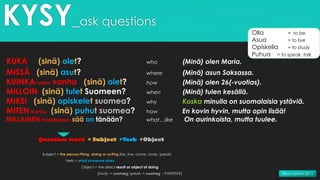

![-ko/-k├Č QUESTION WORD
o AsutKO (sin├ż) Saksassa? Do you live in Germany? asua > sin├ż asut
o PuhutKO (sin├ż) suomea? Do you speak Finnish? puhua > sin├ż puhut
o TuletKO (sin├ż) Suomeen? Do you come to Finland? tulla > sin├ż tulet
o Pid├żtK├¢ (sin├ż) musiikista? Do you like music? pit├ż├ż > sin├ż pid├żt
o OtatKO (sin├ż) kahvia? Will you have some coffee? ottaa > sin├ż otat
-> ŌĆØKyll├żŌĆ”([min├ż] asun, puhun, tulen, pid├żn, otan)ŌĆØ
-> ŌĆØEi...([min├ż] en asu, en puhu, en tule, en pid├ż, en ota)ŌĆØ
-ko: with a, o, u;
-k├Č: with i, e, ├ż, ├Č, y
sin├ż asut
asutko sin├ż?](https://image.slidesharecdn.com/kysy-150123104603-conversion-gate01/85/Kysy-3-320.jpg)
